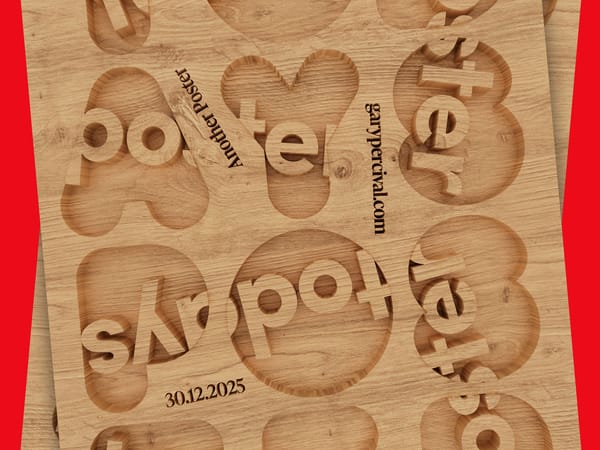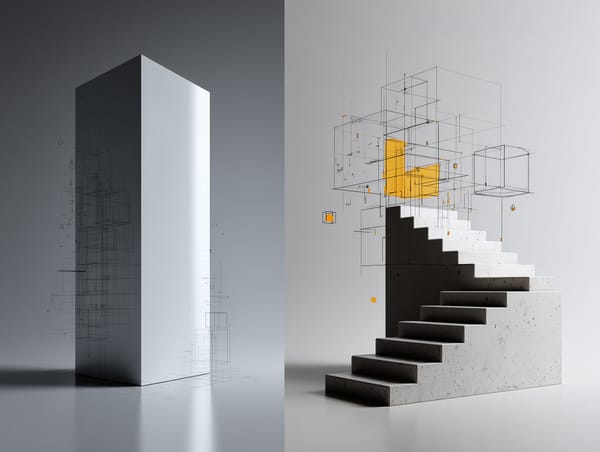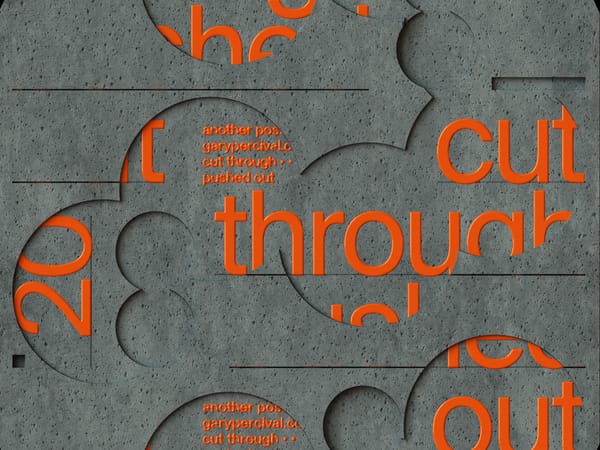Be Cautious With Change: Why We Shouldn’t Always Follow the Latest Fads
When it comes to design, following the latest trends and fads can be tempting.

When it comes to design, following the latest trends and fads can be tempting.
They often promise to deliver something fresh and interesting while also giving us an easy way to stand out from our competitors. But this approach has its pitfalls—too often, we find ourselves falling victim to a fleeting whim or creating work that quickly becomes dated.
With this in mind, let’s explore why keeping up with the latest trends isn't always the best option for freelancers, graphic designers, and other creatives looking to build strong and lasting brands.
Understanding Why Change is Important
Change is an inevitable part of the creative process, and staying ahead of the curve is often what sets successful brands apart from the competition.
However, understanding why change is important and how to capitalise on new trends can be tricky.
First and foremost, embracing change allows us to stay relevant in an ever-evolving market. Trends come and go quickly, and clients look for designers who can keep up with the times. As such, staying informed about the latest design trends is essential for anyone hoping to remain competitive in their industry.
This means being able to quickly identify what new designs are popular at any given moment so you can use them in your own work—or create something even better than the competition.
Additionally, keeping up with changes in design trends allows us to better express ourselves creatively. Whether you’re designing a logo, website, or ad campaign, having access to the latest design tools and techniques can open up a world of possibilities for your creations. With the right resources at hand, you can use new trends to push boundaries and create something truly unique that stands out from other designs.
Finally, understanding why change is important also gives us a sense of purpose when creating designs and projects. When we understand why certain trends become popular, we can then use this knowledge as guideposts when working on projects, so we know where our work should fit within current tastes while still standing out from the competition.
Doing this will help give our work greater impact and meaning, which will help make it more memorable in the eyes of potential customers or employers alike.

The Pros and Cons of Following Fads
As society continues to evolve and more trends emerge, it can be tempting to follow the latest fads and jump on the bandwagon.
This, however, is not necessarily the best option for everyone. To make an informed decision, it is essential to weigh the pros and cons of embracing change.
Let's begin with the benefits of trend-following. Keeping up with the most recent design trends can provide businesses with a competitive advantage and help them stand out from the competition. By understanding current preferences, designers can incorporate them into their work to create designs that are in line with popular opinion and are likely to be well received. In addition, trends can serve as a source of inspiration for those who require additional motivation or new project ideas.
On the other hand, there are disadvantages to closely following trends. It is easy to get caught up in the latest trend and forget to consider whether it is appropriate for you personally or applicable to your situation. In addition, trendy items tend to be short-lived, so any money spent on them may not result in a long-term return on investment.
Lastly, strictly adhering to a trend may necessitate sacrificing quality or originality in your work in order to keep up with what everyone else is doing instead of adding your own unique spin. This could cause your brand to become forgettable or difficult for customers to distinguish from other brands following the same trends.
The dangers of becoming trendy for the wrong reasons
Unfortunately, keeping up with the latest trends can lead to a number of pitfalls.
By attempting to follow the current design trend, we risk creating work that quickly becomes dated; as soon as a new trend emerges, we are left playing catch-up. That is why it is critical to understand why the trend has gained popularity in the first place and to ensure that it is consistent with your overall brand message. When done correctly, embracing a trending style can be extremely beneficial; however, when done incorrectly, it can cause more harm than good.
Another risk of relying too heavily on trends is that you may begin to develop an unoriginal portfolio. Copying other designers’ work or following what everyone else is doing not only harms your creativity but will also fail to make an impact on potential clients or employers. Ultimately, this could limit your long-term success as a designer.
Additionally, paying attention to the latest trends without any critical thought or research can lead designers to spend too much time and energy chasing something that won’t benefit them in the long run. Instead of wasting resources and energy on fleeting fads, consider investing in projects that are timeless or based on classic design principles. These designs will stand out and have staying power, even when fashion changes.
By taking the time to assess each project individually and understand why something is trendy before committing to it, designers can create a portfolio filled with quality work that will last beyond any given trend cycle. Doing so will ensure their brands remain strong and relevant for years to come, all while avoiding any potential pitfalls associated with becoming trendy for the wrong reasons.

Risks Versus Rewards in Embracing Too Much Change Too Quickly
Accepting too much change too quickly is a risky decision for those looking to build strong and lasting brands.
While the latest trends may appear to be tantalisingly fresh and interesting, they leave us vulnerable to falling prey to fleeting whimsy or creating work that quickly becomes outdated. This means that whenever we choose to rely heavily on the latest trends rather than developing our own unique style, we risk sacrificing brand recognition and loyalty in the long run.
The benefits of embracing too much change too quickly are frequently overstated. Many people believe that being trendy automatically translates into success, which is not always the case. While following trends may result in short-term bursts of attention and recognition, it does not always result in long-term success or sustained brand visibility.
In fact, if you're constantly trying to stay on top of what's hot right now without having a clear vision for your own unique style in the future, you might find yourself struggling with identity issues later on.
When it comes to successful design work, the ability to strike a balance between staying contemporary and creating your own timeless aesthetic is critical. Trends should serve as inspiration rather than a game of imitation; focus on drawing inspiration from past works as well as current trends to create something that preserves your individuality and originality while remaining relevant in today's ever-changing market environments.
This will help ensure that your work stands out from the crowd while remaining true to your personal vision and is recognisable across multiple platforms over time—something that can only be accomplished by being skilled at combining both old and new styling techniques in a meaningful way.

How to Tell if Something Is a Passing Fad or Here to Stay
When it comes to graphic design, it can be difficult to tell if something is a passing fad or here to stay.
A quick way to identify a trend is by asking yourself, Do I see this design element being used often, in many different ways? If the answer is yes, then chances are it’s here for the long haul. Trends that don’t have staying power tend to appear suddenly, get overused, and then quickly disappear.
The most important thing we can do is to be mindful as well as intentional about our design choices—consider why a specific element is being included and how it will affect the overall message. Taking the time to evaluate each decision not only helps you create better designs but also encourages creative experimentation. This allows us to push boundaries while still maintaining consistency in our work.
Ultimately, following trends should not be seen as a shortcut to great design but rather as an opportunity to hone our skills and expand our creativity. By understanding what’s trending and why, we can use this knowledge to create designs that stand the test of time.
Recognising Your Own Uniqueness Rather Than Blindly Following Trends
With the rise of social media, new trends and fads have become even more widespread, and it can be tempting to follow them without thinking twice.
However, it is always important to remember that each person has their own individual identity and preferences that should not be forgotten in an effort to fit in with a trend. Realising your own individuality instead of following trends blindly means taking the time to think about your personal style and interests rather than simply conforming to what seems popular at the moment. This involves looking past external pressures from peers, influencers, and others in order to form a deeper understanding of who you are as an individual.
Doing this can help you reach your own creative potential and create more meaningful work that truly reflects your style.
When it comes to creating a brand for your business or portfolio, the importance of authenticity cannot be overstated. Crafting a unique identity is essential if you wish to make a lasting impression on potential clients or employers. Taking the time to research and develop something that truly speaks to your personal style will ensure people remember you not just for being ‘on trend’ but for having an original vision and creativity all of your own.
By doing this, brands become much more powerful as they are capable of inspiring loyalty and trust, which ultimately leads to much greater success.
Overall, being aware of societal pressures while remaining firm in your individual preferences is key to avoiding getting caught up in trends blindly. Doing so will help ensure that you make decisions based on what truly resonates with you rather than following fleeting fads that may soon fade away anyway.

Change can be a great thing. Taking risks and pushing our boundaries can open up many opportunities for growth and learning. However, one should not take change lightly.
We should always consider the pros and cons before making any major decisions. The world is constantly evolving, but that does not mean we have to be swept away every time something new comes along. Being more discerning when it comes to following trends that do not align with our values and desires will help us determine which changes are worthwhile and which are best avoided.
So let’s be mindful of what influences us, take great care in evaluating options, and make well-informed choices that ultimately benefit us in the long run.



